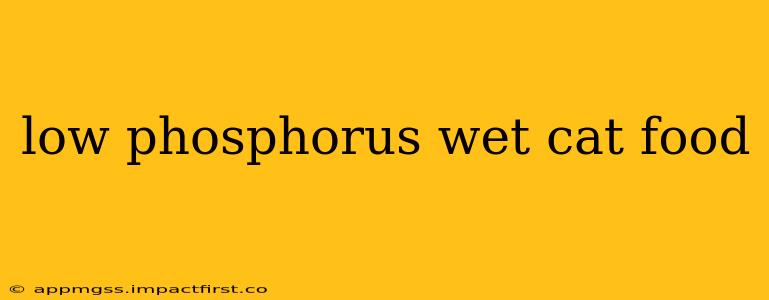Maintaining your feline friend's health is paramount, and for cats with kidney issues, dietary choices play a crucial role. Phosphorus, a vital mineral for bone health in normal amounts, can become problematic for cats with kidney disease. This is because their kidneys become less efficient at filtering phosphorus from the blood, leading to a build-up that can further damage the kidneys. Therefore, choosing a low-phosphorus wet cat food is often a necessary step in managing chronic kidney disease (CKD) in cats. This guide will delve into the importance of low-phosphorus diets, helping you make informed decisions for your cat's well-being.
Why is Low Phosphorus Wet Cat Food Important for Cats?
Phosphorus is essential for healthy bones and teeth, but excessive phosphorus can exacerbate kidney disease. When kidneys are struggling to function properly, they cannot efficiently remove excess phosphorus from the blood. This leads to hyperphosphatemia, a condition characterized by high levels of phosphorus in the blood. Hyperphosphatemia can contribute to:
- Further kidney damage: High phosphorus levels can accelerate the progression of CKD.
- Secondary hyperparathyroidism: This occurs when the body tries to compensate for low calcium levels (often caused by high phosphorus), leading to bone problems and potentially other health issues.
- Cardiovascular problems: High phosphorus levels can contribute to cardiovascular disease.
By feeding your cat low-phosphorus wet food, you actively help manage these risks and improve their quality of life.
What to Look for in Low Phosphorus Wet Cat Food
Choosing the right food requires careful consideration. Here are some key factors:
-
Phosphorus Content: Always check the guaranteed analysis on the food label. Look for food with the lowest phosphorus content possible while still providing adequate nutrition. The label will typically list phosphorus as "phosphorus (P)" or "minimum phosphorus."
-
Protein Source: High-quality protein sources are essential for maintaining muscle mass and overall health, especially in cats with CKD. Look for foods that list specific and recognizable protein sources like chicken, turkey, or fish.
-
Other Nutrients: Ensure the food contains appropriate levels of other essential nutrients like vitamins, minerals (excluding excessive phosphorus), and fatty acids. A balanced diet is crucial for overall health.
-
Palatability: It's crucial that your cat enjoys the food. If your cat refuses to eat, the best low-phosphorus food is useless. Consider offering small samples of different brands to find one your cat will happily consume.
What are the Different Types of Low Phosphorus Wet Cat Food?
The market offers a variety of low-phosphorus wet cat foods, catering to different palates and needs. Some brands specialize in prescription diets formulated by veterinarians for cats with specific health conditions, while others offer commercially available options with lower phosphorus content. Prescription diets often have very precisely controlled levels of phosphorus and other nutrients, while commercially available options may have slightly higher phosphorus levels but are still considered suitable for many cats with early-stage CKD.
How Much Low Phosphorus Wet Cat Food Should I Feed My Cat?
The amount of food you should feed your cat will depend on their individual needs, age, activity level, and the specific recommendations from your veterinarian. Always follow the feeding guidelines provided on the food packaging, but discuss the appropriate feeding amount with your vet to ensure your cat is receiving optimal nutrition without excessive phosphorus.
Can I Make My Own Low-Phosphorus Wet Cat Food?
While you could try making your own low-phosphorus wet food at home, it's extremely challenging to ensure a perfectly balanced diet with the right nutrient levels, particularly with the low phosphorus requirements. Incorrect formulation could result in nutritional deficiencies. Consult your veterinarian before attempting this. They can guide you on formulating a safe and balanced homemade diet if that's deemed appropriate.
My Cat Won't Eat Low-Phosphorus Wet Food – What Should I Do?
Many cats initially resist changes to their diet. Try introducing the new food gradually by mixing it with their regular food, increasing the proportion of low-phosphorus food over several days. You can also try warming the food slightly to enhance its aroma, or offering it in a different bowl or location. If your cat continues to refuse the food, consult your veterinarian for advice. There may be other underlying issues or alternative dietary approaches to consider.
Conclusion
Selecting the right low-phosphorus wet cat food is vital for managing kidney disease in cats. By carefully considering the factors outlined above, and working closely with your veterinarian, you can help ensure your feline companion receives the optimal nutrition they need to maintain a good quality of life. Remember, regular veterinary check-ups and monitoring are crucial for managing CKD effectively.
